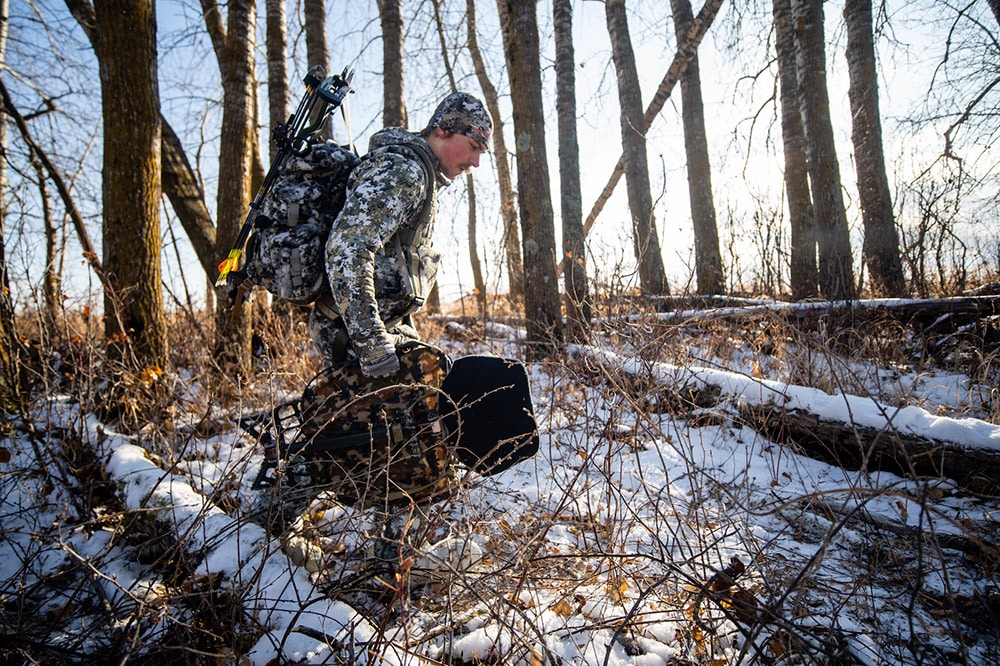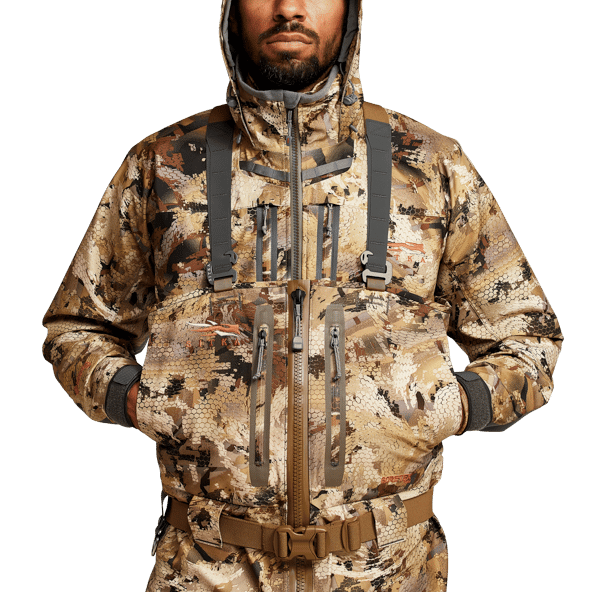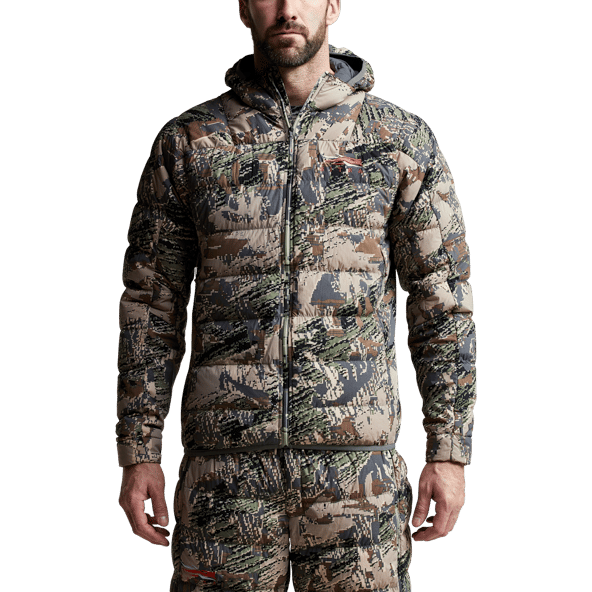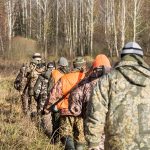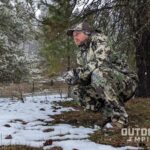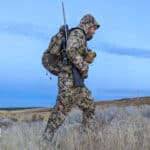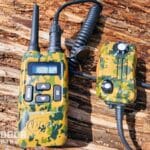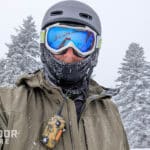With various patterns available for every type of terrain in North America, it can be difficult for everyday outdoorsmen and hunters to select the correct camouflage pattern for their unique needs.
One of the most well-known companies producing high-quality, durable camouflage is SITKA Gear. Sitka camo patterns encompass every kind of North American terrain and habitat.
Sitka uses a family of camouflage patterns referred to as GORE® OPTIFADE™ Concealment. Gore® Optifade™ was developed by W.L. Gore & Associates who owns the famous GORE-TEX brand. Optifade technology is used on Sitka camo gear in five color variations designed for different environments.
Optifade is based on the science of how deer and other animals see space and color. It is a breakup pattern designed to conceal the hunter from being recognized as a predator as opposed to more traditional mimicry-based camouflage, which makes the hunter match his surroundings.
In this article, we cover each of the camouflage patterns produced by Sitka and the environments for which they are best suited.
What Camo Patterns Does Sitka Have?
There are five major Sitka camo patterns in their catalog that cover the bases of most environments in North America. The Sitka pattern names are:
- Optifade Open Country
- Optifade Subalpine
- Optifade Elevated II
- Optifade Waterfowl Marsh
- Optifade Waterfowl Timber
Each has a distinct look and purpose, with patterns that conceal a hunter in the environment.
For instance, Subalpine and Elevated II have a digital pattern that uses pixelated patches of contrasting colors that break up shapes well.
The Waterfowl patterns have a scale-like base pattern, covered with swirling patterns ranging from black to every shade of brown.
Open Country was the first pattern created by Sitka using any form of digital camouflage, and its pattern is reminiscent of 1980s food court cups. A solid slate-like base is covered with stripes resembling claw marks, ranging from purplish grey to brown and black.
Each pattern specifically targets prime hunting habitats throughout the United States. End users must be able to distinguish which pattern is right for them. Below, we go into detail about each Sitka pattern name, the environment it’s intended for, and some of the best gear Sitka offers in that pattern.
Waterfowl Timber
Species: white-tailed deer, waterfowl, varmint
Ideal locations: Southeastern US
Environments: swampland, forested wetlands, Southern forests, cypress swamps
Waterfowl Timber is one of the patterns I have the most experience with. It’s optimal for southern United States woodlands and marshes.
Excellent for duck hunting in marshes and deer hunting in tree or box stands, the pattern was designed to blend into the marsh brush and water surfaces to conceal a hunter’s presence from incoming ducks.
This pattern does an excellent job of concealing humans at close range from the prying eyes of ducks and deer. Perfect for hunting inside 50 yards, the waterfowl timber pattern is a durable, breathable camouflage pattern that accentuates the dark, earthy tones of the marshes and woodlands of the Southeastern US.
Gear Recommendation
Temperatures rarely drop beneath 30°F in the Southeast. Most of the hunting season in my home state of Louisiana and of neighboring Mississippi is usually between 35° to 70°F. So heavy, bulky clothing is suboptimal for hunters looking to sit in tree stands for an extended period of time.
With hordes of mosquitoes buzzing about, early bow season can be uncomfortably warm to wear conventional camouflage. Sitka’s Core Lightweight Hoody has a conveniently built-in pull-up face cover. Paired with the Gradient pants in the Waterfowl Timber pattern, it makes for excellent bow hunting attire in warm weather.
Waterfowl Marsh
Species: white-tail, mule deer, waterfowl, dove
Ideal locations: Southern and Central United States
Environments: cane, corn, wheat or other fields, marsh grass, tall grass, high weeds, open marshland
The first time I observed Waterfowl Marsh was during a 2020 dove hunt in southern Alabama. Blending in perfectly with the cane fields, the hunter clad in this extraordinary pattern was nearly invisible to the incoming birds and used this to his advantage.
While the rest of us sat just inside the tree line, he used the high-contrast pattern designed to blend into standing marsh grass, tall crops, dead cane, and wheat to stake his claim much closer to the field’s center. Needless to say, he limited out quickly.
While the Waterfowl Timber works well in heavily forested swamps and wetlands, the Waterfowl Marsh pattern is perfectly tailored for open marshland. With its large pockets of open water dotted with weeds and tall grass islands, this design fits right in.
Designed to confuse bird and deer depth perception, the colors incorporated into the Waterfowl Marsh pattern create a 3D flurry of swirls and scales that baffles even the human eye at a distance.
Gear Recommendation
One of the best products in this pattern is the Delta Zip Wader. Completely waterproof, the Delta Zip Wader cloaks a hunter from the knees up in the Waterfowl Marsh pattern.
Reinforced knees and shins with foam padding ruggedize the wader against everything the brush and frozen marshes can throw at it while you’re out chasing birds. This wader can also serve as an outer layer of insulation for a deer hunter in a ground blind in marshy terrain.
One of the best products Sitka has ever come up with is the Jetstream Jacket. And it’s a game changer in the Waterfowl Marsh pattern.
This wind stopper, lined with microfleece, retains warmth while staying breathable and somehow still sheds rain and repels wind. This jacket is perfect for an open marsh duck hunt or ground blinds. It allows hunters to remain unaffected by ever-changing weather conditions.
If it sounds like this jacket can do it all, that’s because it can. It sits as one of my all-time favorite Sitka Products.
Subalpine
Species: elk, mule and white-tailed deer, pronghorn antelope
Ideal locations: broad range throughout the US from the Northeast to the Mountain West, can be used in most states
Environments: correlated open terrain with heavy ground vegetation mixed with forest, lower portions of mountains, foothills, backcountry, grassland
Probably the most recognizable pattern Sitka has available, Subalpine looks like a video game camouflage to the naked eye. Up close, it can seem over-digitalized, pixilated like a 2000‘s computer game, but it would be a mistake to underestimate the concealment the Subalpine pattern has to offer.
Subalpine is the most versatile camouflage pattern Sitka has available. This pixelized pattern is designed for on-the-ground stalks where hunters will be in vegetation-filled terrain, having to close within 50 yards to make shots. It’s an excellent choice for big-game bowhunters.
One of the benefits of this unique pattern is that it helps conceal hunters on the move. Staying away from conventional stripes, swirls, or scales, the obtuse digital pattern breaks up the upright human frame into contorted splotches. Because of this, it is nearly impossible for an animal to identify hunters correctly.
Gear Recommendation
Two of the best Sitka gear in Subalpine are the Traverse Pants and the Ambient Hoody. As previously mentioned, Subalpine allows hunters to move well without being detected. The Traverse Pants are made of polyester that is water repellent, quiet, and 4-way stretch.
This combination of mobility, stealth, and insulation ensures that hunters can move freely and dry on a stalk without fear of being given away from fabric-on-fabric noise.
The Ambient Hoody blends lightweight with insulation. This pairing creates the perfect combo of Sitka gear for hunters on the stalk for sharp-eyed and keen-eared muleys or elk.
Elevated II
Species: white-tail, elk, mule deer
Ideal locations: throughout much of the US, especially the Northeast and Great Lakes regions
Environment: heavily to moderately forested locations with tall trees, from a treestand, best in environments that frequently receive snow
For those late-season hunts where the temperature is at its lowest, the snow has fallen, and the deer are their wariest, it seems hunters can do no right with their camo selection. Sitka attacked this problem with their Elevated II pattern.
It combines the grays and whites of cloud cover with the browns of a forest background. This creates the ultimate tree stand camouflage.
Made with a proprietary polyester fabric that is ultra quiet, this line of camouflage is perfect for skittish whitetails. But it works just as well when hunting muleys or elk. Elevated II is a blend between Subalpine and Open Country in its pattern, with pixelated splotches and chalky streaks, designed for hunters looking to take longer shots.
While it’s not a pattern for stalking, this camouflage will conceal hunters hidden in a tree stand. It combines many colors to blend the wearer into the skyline and foliage, making them a ghost to the unsuspecting quarry.
Gear Recommendation
Two of the best products Sitka makes in Elevated II are the Fanatic Jacket and the Downpour pants. The Fanatic is possibly the quietest hunting jacket I’ve ever worn. Its Berber fleece face makes it virtually mute, without restricting movement, when you need to draw a bow or check behind the stand.
One of the unique factors and reasons I love the Elevated II Fanatic Jacket so dearly is its pass-through port for treestand safety harnesses.
Rather than affixing an external harness outside your camouflage, disrupting both the pattern and bumping into your gear, the pass-through port allows hunters to clip into a harness beneath their outer layer for seamless movement and unbroken camouflage.
The Downpour Pants are the bottom half answer to noiseless camo in bad weather. They use 3-layer Gore-Tex fabric to repel rain without giving off that hard splat tech shell that rain-repellent pants are known for.
Open Country
Species: moose, goat, sheep, elk, mule deer
Ideal locations: Central and Northern portions of the continental US, Alaska
Environments: above the tree line, mountainous, rocky terrain
Open Country lives up to its name as the premier camouflage for big game animals. Sitka created the first ever digital pattern to dissipate the human form into the background, hiding the bipedal predator from its quarry.
Meant for hunting locations where trees are sparse and rocks are plentiful, this is many hunters’ choice when targeting big horn sheep and mountain-dwelling goats due to its swaths of every shade of brown, black, and chalky slate.
While the pattern to me is reminiscent of old-school wax cups, it is on the cutting edge of camouflage technology. It enables hunters to seamlessly blend into some of North America’s most rugged and austere terrains.
Most often used above the tree line, I have seen this pattern used in locations such as Alaska, Canada, Colorado, and Utah by big game hunters searching for prey at elevation. This is not a sit-and-wait camouflage but rather closely resembles Subalpine, a stalker-friendly pattern that breaks up movement with its pixelated design.
Gear Recommendation
Two of the best products in the Open Country pattern that Sitka makes are the Kelvin Lite Down Jacket and ¾ Pants. At altitude with little cover, the elements can be brutal to hunters. The Kelvin Lite down Jacket sets the gold standard of insulation and comfort but it packs down small and light so you’re not carrying extra weight in the Alpine.
The ¾ Pants are a unique product from Sitka, stopping just beneath knee pads but above the boot to maintain insulation without excess material when ounces equal pounds in open country. A built-in nylon belt helps ensure a snug fit.
How to Choose Sitka Camo
Sitka camo should be selected by two criteria:
- Terrain
- Weather
Terrain is the basic building block of your camouflage pattern selection. It includes the vegetation on location, the kinds of soil or rock background you will encounter, and whether you will be stalking, sitting in a tree stand, in a duck blind, or hiking through mountains.
Weather changes far more than terrain ever will. It can turn a great day of hunting into a bust with a simple change in the wind. While the weather is a factor in the pattern you select, it has the greatest impact on the actual type of hunting clothing you’ll want to wear. So pay close attention to the weather during hunting season.
Selecting a Sitka pattern that doesn’t match the environment can end a hunt before it even starts. For instance, if you purchase a Subalpine Core Lightweight Hoody and Traverse Pants expecting to hunt in Montana before snowfall, this would be a safe bet.
However, later in the season, when the ground is laden with snow, casting the entire terrain in white snow, hunters will stick out like a sore thumb in the digital Subalpine pattern.
When selecting the Sitka pattern for your next hunt, consider the time of year and location. Through a quick Google search, hunters can look at photos of their target area during each season or call the local game warden to help determine the camo patterns they need.
Final Thoughts
Sitka is one of the most reputable camouflage brands in the outdoor and hunting industry. Combining high-quality materials with advanced camouflage patterns, Sitka provides some of the best outerwear for hunters available on the market today.
Some of Sitka’s line has even been adopted by tier 1 units inside the United States military for their quality designs and realistic camouflage patterns.
Having worn several different Sitka camo patterns while hunting, I can speak firsthand to their effectiveness in the field and ability to conceal hunters from their prey. The material that makes each piece of clothing is incredibly durable, season in and season out.
Unfortunately, mine no longer fits as it is not built to withstand a growing beer belly.

